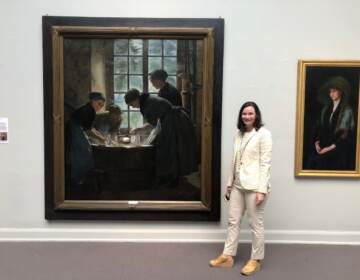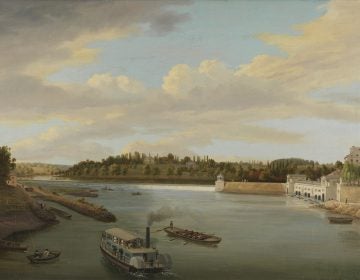A ‘Philadelphia Cornucopia’ diminished but still impossible to ignore

Red Grooms' 'Philadelphia Cornucopia' was created for the city's tricentennial in 1982. (Emma Lee/WHYY)
In honor of the Democratic National Convention, the Pennsylvania Academy of Fine Arts this summer is hosting too many Washingtons to count. Legions of Georges (and Marthas) populate “Happiness, Liberty, Life? American Art and Politics,” a survey of artistic political expression — from criticism to adulation and commentary to mockery.
Together again: George, Martha, Tom, and Ben
Though only a portion of the exhibit, the Washingtons demonstrate its range. There’s George as Greek god, George as depicted on the dollar bill, and a contemporary George, with his inaugural words literally spilling from his mouth. But the George I most wanted to see was Red Grooms’ interpretation in “Philadelphia Cornucopia” (1982).
I first saw “Philadelphia Cornucopia” 34 years ago, and I have never forgotten it. Grooms had been commissioned to create an installation piece for Philadelphia’s 300th anniversary, and he designed it for the cavernous Institute of Contemporary Art in University City. The result, which towered over viewers, was a goofy, good-natured salute to the founders. Parade float-sized, with gargantuan figures and numerous painted backdrops, “Philadelphia Cornucopia” made its debut while the city was still recovering from 1976. (For those who don’t remember the Bicentennial, it was a long time before any of us wanted to see anything red, white, or blue.)
Considering the timing, the public might have understandably ignored Grooms’ Yankee Doodle-infused work. But “Philadelphia Cornucopia” proved so popular that, instead of it returning to the artist’s studio after the ICA exhibit, funds were raised to keep it here.
It was exhibited in Independence National Historical Park and at 30th Street Station in the 1980s, and eventually wound up in storage at the Philadelphia Commercial Museum, commonly known as the Civic Center Museum, which closed in 1994.
As originally conceived, “Cornucopia” was a sprawling work that, as it was intended to be temporary, was never properly conserved. Combined with its checkered provenance, intact survival was unlikely. Many parts were damaged, others disappeared. In 2010, the remains came to PAFA, which this year undertook restoration for this summer’s exhibit. Its history and restoration are detailed in an article by Sharon Reid of PAFA.
Mad Magazine meets the History Channel
Even in its somewhat diminished state, “Philadelphia Cornucopia” still looms over viewers as they enter the Fisher Brooks Gallery. Four figures are positioned as if on a sailing ship. Martha constitutes the prow. George stands behind her, holding a telescope and looking toward the horizon. Farther back, resplendent in a red robe and gazing imperiously over his shoulder, is Thomas Jefferson. Sitting placidly in the stern, holding a tiny kite, is Ben. (And if you don’t know which Ben, get out of town.)
Prior to creating Philadelphia’s tercentennial work, Grooms, a multimedia artist represented in collections that include the Metropolitan Museum of Art, had caricatured Chicago and New York in “The City of Chicago” (1967) and “Ruckus Manhattan” (1975/76). He calls these “sculpto-pictoramas,” enormous conflations of fact, legend, and stereotype, executed in a Mad Magazine-meets-the-History Channel style. Think respectful irreverence.
Though there’s much more to see in “Happiness, Liberty, Life?” it was worth my time just to revisit “Philadelphia Cornucopia.” More than three decades on, a little worse for wear, it still makes me smile. And in this presidential year, that’s an achievement.
WHYY is your source for fact-based, in-depth journalism and information. As a nonprofit organization, we rely on financial support from readers like you. Please give today.




